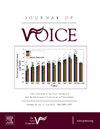Evidence on Vocal Interventions in Adults: A Scoping Review
IF 2.4
4区 医学
Q1 AUDIOLOGY & SPEECH-LANGUAGE PATHOLOGY
引用次数: 0
Abstract
Objective
To map the evidence on vocal intervention in people over 18 years old.
Methods
A literature search was conducted using the following electronic databases: Cochrane Library, EMBASE, Latin American and Caribbean Literature on Health Sciences (LILACS), LIVIVO, Pubmed/Medline, Scopus, SpeechBITE, and Web of Science. Gray literature was also used as an information source through searches on Google Scholar, Open Grey, ProQuest Dissertation and Thesis, and the Brazilian digital library of theses and dissertations. Systematic reviews (SR) with a population of individuals over 18 years old were included. The included reviews addressed speech-language pathology interventions in the vocal area with reports of their respective outcome. The methodological quality of the included systematic reviews was analyzed using the AMSTAR II tool. Quantitative analysis was performed by frequency distribution, and qualitative research was analyzed through narrative synthesis.
Results
A total of 2,443 references were retrieved, among which 20 studies met the inclusion criteria. The included studies had critically low quality, lacking the use of population, intervention, comparison, and outcome (PICO) components. Among the included SRs, 40% were made in Brazil, 45% were published in the Journal of Voice, and 75% analyzed dysphonic patients. The most frequent intervention was voice therapy (direct therapy associated with indirect therapy approaches). Positive results were observed in most of the outcomes for all studies.
Conclusion
Voice therapy was described as inducing positive effects for voice rehabilitation. However, due to the critically low quality of studies, the literature did not enable us to understand the best results for each intervention. Well-designed studies are necessary to clarify the relationship between the intervention goal and how the intervention was evaluated.
成人声音干预的证据:范围回顾
目的了解18岁以上人群嗓音干预的相关证据。方法采用Cochrane Library、EMBASE、Latin American and Caribbean literature on Health Sciences (LILACS)、LIVIVO、Pubmed/Medline、Scopus、SpeechBITE、Web of Science等电子数据库进行文献检索。通过谷歌Scholar、Open Grey、ProQuest Dissertation and Thesis以及巴西论文和学位论文数字图书馆的搜索,Gray文献也被用作信息来源。纳入了18岁以上人群的系统评价(SR)。纳入的评论涉及语音区域的语言病理学干预,并报告了各自的结果。使用AMSTAR II工具分析纳入的系统评价的方法学质量。定量分析采用频率分布法,定性研究采用叙事综合法。结果共检索文献2443篇,其中符合纳入标准的文献20篇。纳入的研究质量极低,缺乏使用人群、干预、比较和结果(PICO)组成部分。在纳入的SRs中,40%是在巴西制作的,45%发表在《声音杂志》上,75%分析的是发音障碍患者。最常见的干预是语音治疗(直接治疗与间接治疗相结合)。所有研究的大多数结果均为阳性结果。结论语音治疗对语音康复具有积极的诱导作用。然而,由于研究质量极低,这些文献并不能使我们了解每种干预措施的最佳结果。精心设计的研究是必要的,以澄清干预目标和干预如何评估之间的关系。
本文章由计算机程序翻译,如有差异,请以英文原文为准。
求助全文
约1分钟内获得全文
求助全文
来源期刊

Journal of Voice
医学-耳鼻喉科学
CiteScore
4.00
自引率
13.60%
发文量
395
审稿时长
59 days
期刊介绍:
The Journal of Voice is widely regarded as the world''s premiere journal for voice medicine and research. This peer-reviewed publication is listed in Index Medicus and is indexed by the Institute for Scientific Information. The journal contains articles written by experts throughout the world on all topics in voice sciences, voice medicine and surgery, and speech-language pathologists'' management of voice-related problems. The journal includes clinical articles, clinical research, and laboratory research. Members of the Foundation receive the journal as a benefit of membership.
 求助内容:
求助内容: 应助结果提醒方式:
应助结果提醒方式:


